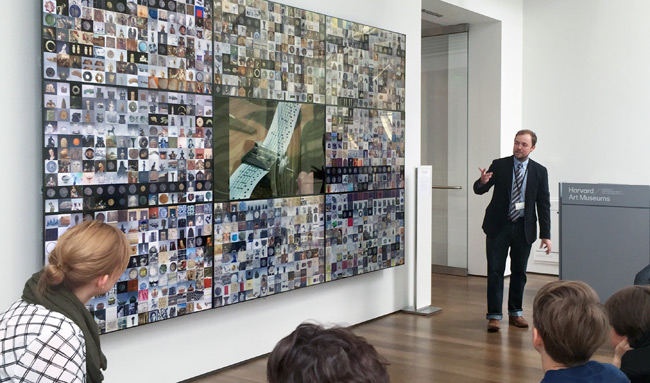Digital Humanists Matthew Battles and Michael Maizels conjecture that ‘the beginnings of modern art history, as a field, are inseparable from the technology—photography—that made such interobject comparisons possible’. Comparison is the key concept here; the ability to view two or more pieces of artwork in direct conjunction to one another can bring to light hugely interesting details which may not have been observed if the pieces had been seen in isolation. Interestingly, the period in which modern art history emerged is the same period in which the modern museum began to take shape: the nineteenth century. The early museum allowed for objects of historical or aesthetic significance to be seen in direct conjunction to one another by the public, whereas objects of such value had previously been designated only for the wealthy to purchase and display in their homes. Today, the museum’s purpose has developed, but still rests on the concept that it is beneficial for the public to be able to access and explore their own cultural heritage. With the advance of technology, the digitisation of museum collections is now a relative commonplace. National organisations and institutions such as The British Museum, The V&A, The British Library, and Royal Collection Trust all have significant portions of their collections available to view and explore online, often with accompanying data about the object’s location, condition, and accession or catalogue number, which could not be derived from looking at the physical object itself in a museum setting. At what point, then, is the physical artefact not enough? Is the digitisation of museum collections the future of how we interact with our cultural heritage?
There are undoubtedly huge benefits to the digitisation of museum collections, of which the most important is accessibility. Making objects available to view online in high quality is not only an excellent way to facilitate research and interest in these objects for anyone with an internet connection, but it also opens up heritage to a much wider audience, particularly those of a younger demographic. Digitisation also makes the logistics of cataloguing and archiving much easier, photographs can be used as ‘surrogate objects’, as Battles and Maizels point out, which allows collections to be compared, organised, and sorted without undue risk to the objects themselves. Digital cataloging can also allow the object to be viewed in much greater detail than it could ever be with the naked eye, furthermore, photography allows for an object to be frozen at a point in its lifetime, after which damage or degeneration may occur. Thus, the digital version preserves the object in its present state, allowing it to be viewed in its superior condition, even after it may have deteriorated.
The benefits of digitisation are clear, but that does not mean there are no downsides. A digitised artwork has no sense of scale or physical impression. In many instances, seeing a particular painting hung on a wall, displayed as it was likely intended to be seen by the artists, has the emotional or aesthetic effect that art is often intended to bring about. Furthermore, there are some art works – performance art or site specific art for example – which cannot be digitised. Additionally, the online archive, though vast and easy to navigate, must ultimately be maintained at its source, and the rapid speed of technological development may mean that without attendance, digital archives will cease to function at all. Finally, recent developments in conservation technology have allowed new insights into artworks and the artistic processes used to create them. The x-raying of paintings for example, can reveal the layers of paint used, details of the object’s construction, lines which were erased from the final piece, and artists marks invisible under normal conditions. Similar processes have been undertaken for historic clothing as well as paintings, as conducted at the V&A. The digitisation of collections has its benefits then, but it cannot detract from the essential place of the physical object in the museum collection.
There are instances, however, of the digital and the physical being brought together to work to the benefit of the museum in unison, without one detracting from the other. The metaLAB object map instillation in the Lightbox Gallery at Harvard Museum aimed to tackle this problem in which the digitised item, while fascinating and valuable, is no substitute for the original. Through a remote controlled interface, viewers could scroll through nearly all the objects in the museums collection, by clicking on a single object they could view all the associated raw code that comes with that object’s digital self, including information such as the number of page views for that object, the number of times it has been exhibited, and its physical location in the museum itself. Ming Tu, the museum’s technology fellow at the time, said: “We want to make this precious data accessible, meaningful, and playful to our visitors.” The idea of play is a huge draw for museums today. In a world where technology can bring us media in seconds and social app algorithms analyse our likes and dislikes to show us exactly what we want to see, holding a visitor’s attention in a museum setting is proving increasingly difficult. The metaLAB project allows visitors to explore the collection in digital and physical form, facilitating engagement in the physical collection as well as acting as an art instillation in and of itself: the digital archive has many uses.
So, is the digital museum the future? Probably not. While digitisation has revolutionised the way museums view, store, and navigate their collections, the physical object should, and likely shall, remain king. That being said, not all museum have the budget for such digital undertakings and many are at risk of disappearing altogether due to lack of visitors and funding. While digital cataloguing in the small scale is possible, the vast public databases linked at the start of this post are impossible for all museums to achieve, and as such, many collections remain hidden. Just as artworks in the pre-museum environment remained accessible only to the wealthy, digitisation of artworks is not something which is available to all.
Works Cited:
Springing to Light, Harvard Museum.,15 May 2015, [Accessed: 24th January 2022]
Matthew Battles and Michael Maizels, ‘Collections and/of Data: Art History and the Art Museum in DH Mode’ in Debates in the Digital Humanities 2016.



